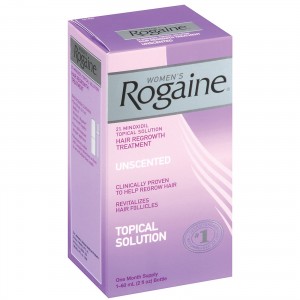- Pregnancy
- Traction alopecia
- Lack of sleep
- Poor diet
- Bad circulation
- Iron deficiency
- Folic acid deficiency
- Stress
However, the leading cause of women’s hair loss is female pattern baldness, or androgenic alopecia. This condition is different in women than it is men, largely because it lacks the prevalent genetic factor, and also because it’s a byproduct of the natural aging process—a culmination of hormonal changes.
Female Hair Restoration with Rogaine

The next quandary to typically follow suit after a female pattern baldness diagnosis is: what’s the cure? Hair transplantation is as viable and permanent an option for women as it is for men. However, for those seeking non-surgical hair restoration, the male-female equilibrium of options changes. The two FDA-approved non-surgical hair loss treatments are:
- Finasteride (Propecia)
- Minoxidil (Rogaine)
Propecia is contraindicated in women and, therefore, off limits. But Rogaine is okay for female hair restoration. The women’s formula lining the shelves of your local pharmacy comes with a 2% concentration of minoxidil, while the men’s formula contains five percent. However, there are some cases for which a doctor may even recommend that his/her female patient use the 5% dose. Every person is different. If you are suffering severe female hair loss, unsure whether or not to try the higher dosage, check in with your physician or a hair loss specialist.
Rogaine may have side effects, especially in higher concentrations of minoxidil. This may include:
- Scalp itching
- Scalp irritation
- Facial hair growth
